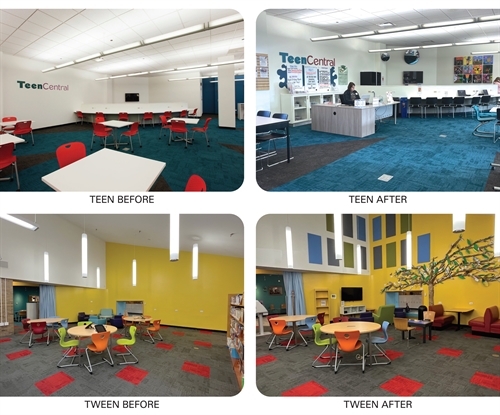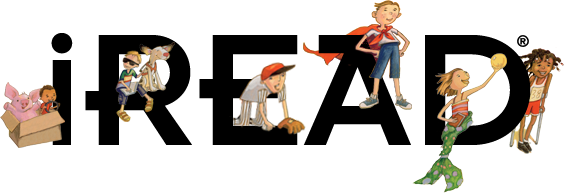June 2025 | Volume XLIII, Issue 2 »
Small Changes, Big Impact: Reimagining Existing Spaces for Teens and Tweens
June 2, 2025
Jen Ryjewski, Downers Grove Public Library
As we wrapped up our yearlong strategic planning process at the Downers Grove Public Library (DGPL) at the end of 2023, one thing became crystal clear from the feedback we received through community surveys and focus groups: the urgent need for a revised approach to teen and tween engagement, services, and spaces. The calls for an enclosed teen area and a dedicated space for tweens (ages 8-12) ranked first and third among 44 suggested improvements throughout the library. These top-ranking suggestions were not just wishes, but a real call to action from the community—and it was our responsibility to bring them to life.
When we created our existing Teen Central area in 2014, which boasted an open floorplan in a far-off corner of our second floor, a large soft-seating area, video gaming, group study tables and rolling chairs (big mistake), an arcade machine, and a robust, popular teen book collection with broad appeal, we naively thought this was exactly what the teens wanted. However, as the years passed, we realized that our “if you build it, they will come” philosophy overlooked several important factors, including logistics, staff supervision, structured activities, and most importantly, teen boredom, angst, and disengagement.
While well intentioned, Teen Central did not receive the type of use we originally thought it would. It became an indoor playground of sorts, providing opportunities for teens to utilize the soft seating as platforms from which to jump, dive, and perform aerial acrobatics, or use the wheeled study chairs to amuse themselves in tournaments of crash bumper cars. Due to its secluded location, tucked away from the line of sight of staff, Teen Central offered just enough privacy for teens to act with a sense of impunity and for the whodunits to claim “I didn’t do it!” Despite having several security cameras in place, building operations monitors patrolling the library regularly, and a poster-sized placard highlighting our Code of Conduct, we just could not get the teens to behave, and quite frankly, we got to the point where there was a sense of relief when they left.
Expected and desired behavior was a challenge to enforce and sustain. Teens who earnestly wanted to use and enjoy Teen Central for its intended purposes could not do so without bother or interruption, and therefore, would vacate the space entirely. Teens who misbehaved were asked to leave, some even banned for a predetermined period of time, e.g., the day, a week, etc. (depending on the severity of their behavior). In either event, Teen Central was often left a ghost town, bereft of the teens we were so eager to engage and serve.
Staff made genuine attempts to serve the educational and recreational needs of the teens and develop meaningful and lasting relationships with them, but their behavior made it nearly impossible. We struggled tirelessly to get teens to follow our rules for requisite behavior and no matter what or how hard we tried, we failed. We knew we had a problem that needed fixing and the feedback we received through our community surveys and focus groups was the impetus.
We went to work analyzing our existing floor plan to see what types of changes and improvements we could make with in-house talent and resources, without having to invest in a professional space study or architectural renderings (as that was of a future, library-wide concern). As we brainstormed potential configurations for reimagined spaces, we kept several factors in the forefront of our minds: proximity of teen/tween spaces to quiet study areas and capacity for noise control; staff sight lines and security camera visibility; access to electrical outlets and data; necessity and feasibility of moving furniture and shelving; and costs for supplies, furniture, and equipment.

The results included two completely new and separate reimagined spaces: one in the Children’s Department for tweens (ages 8-12); and the other in Teen Central for teens (ages 13-18). By reimagining and restructuring these spaces, we could provide two different, yet similar, age groups with welcoming, engaging, and safe spaces, programs, and activities that would allow them to successfully discover, grow, play, and learn.
The new tween area seamlessly incorporates the décor and color scheme consistent with the rest of the Children’s Department, ensuring it feels intentional and cohesive rather than an afterthought. The previous space featured little more than four study tables with chairs. The reimagined space includes the same bright and bold colors, a mix of new and repurposed comfortable seating (including booth seating), and modern furnishings and equipment. This transformation supports a wide range of activities, from studying and reading to relaxing, socializing, and engaging in interactive play. The goal was to blend the excitement of entertainment and socializing with friends with the stimulation and appeal of learning and discovery. Beyond the new and repurposed décor and seating, we achieved this by:
- Purchasing a self-service tablet station (Hublets by Envisionware) where tweens can check out tablets to use for homework or access educational and recreational games;
- Adding a digital touchscreen play table, which includes games like “air” hockey, tic-tac-toe, memory games and puzzles, and activities like painting, drawing, and so much more;
- Creating an additional gaming area, which includes Playstation 4, Xbox, and Switch video gaming systems; and
- Converting our STEM room to a more flexible makerspace by replacing the carpet flooring with a vinyl option, adding more counter tops and moveable tables and seating for flexible make-and-create programs, and extra storage units to house maker equipment and supplies for easy and swift access.
The tween area also has a specially-curated book collection that includes textbooks, graphic novels, comics, a diverse range of popular reading materials, and flexible and collaborative spaces where tweens can work on group projects, engage in discussions, hang out with friends, or participate in library programs.
We improved Teen Central by rearranging the shelving to create a more enclosed space in order to mitigate noise; adding a public service desk, which is staffed by teen librarians during off-school hours, and adding storage units to house games and makery and crafting supplies. By implementing these small changes, we have virtually eliminated our behavioral incidents involving teens and more than doubled program attendance and participation.
By creating a supervised space and providing easy access to staff, Teen Central is no longer the former ghost town on the second floor. While the teens are still high energy and curious, and possess a desire to test boundaries at times, they are respectfully engaged with one another and staff and their behavior has improved astronomically. The teens are in the building!
These new and improved tween and teen spaces mark a very exciting turning point in our continued commitment to serving the evolving needs of our community and ensuring everyone is welcome to discover, grow, play, and learn. We are excited to welcome all tweens and teens to explore and enjoy these vibrant and innovative new spaces which aim to captivate young minds; promote curiosity, exploration, and fun; and encourage wonder and a sense of adventure at the Downers Grove Public Library.

 iREAD Summer Reading Programs
iREAD Summer Reading Programs Latest Library JobLine Listings
Latest Library JobLine Listings